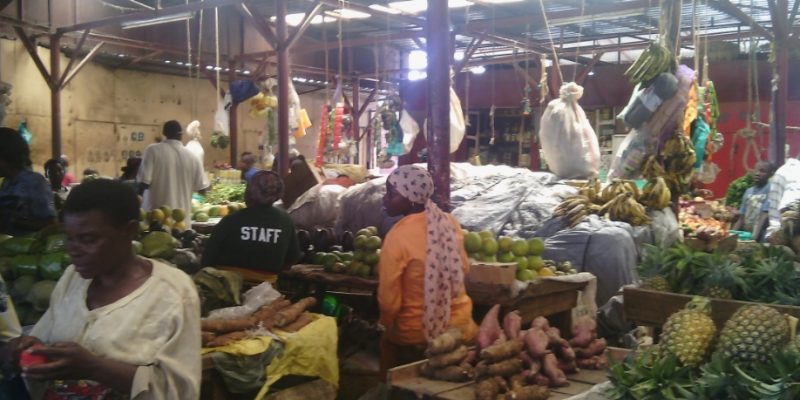A Fairer World May Mean More Modest Dreams
Basic needs for all can probably be met sustainably, a new study finds—but a higher level of life satisfaction may be incompatible with a sustainable planet. "Countries that are using resources at a sustainable level ... fail to meet the basic needs of their people,” says a co-author of the report in Nature Sustainability. (Moses Mbumay / Wikimedia Commons)
"Countries that are using resources at a sustainable level ... fail to meet the basic needs of their people,” says a co-author of the report in Nature Sustainability. (Moses Mbumay / Wikimedia Commons)
A sustainable planet may not be attainable, and a fairer world may require us to temper our dreams. Justice, equity, sanitation and even clean water may be within the reach of all, but only if many of the planet’s seven billion humans give up the dream of high life satisfaction as well.
To achieve that difficult-to-define state of mind would require the resources of between two and six planet Earths, according to a new study in a new journal that takes the concept of sustainability and applies some planetary arithmetic.
“We examined international relationships between the sustainability of resource use and the achievement of social goals, and found that basic needs, such as nutrition, sanitation, and the elimination of extreme poverty, could most likely be achieved in all countries without exceeding global environmental limits,” said Daniel O’Neill, who directs the Sustainability Research Institute at the University of Leeds in the UK.
“Unfortunately, the same is not true for other social goals that go beyond basic subsistence such as secondary education and high life satisfaction. Meeting these goals could require a level of resource use that is two to six times the sustainable level.”
Sustainability missed
Dr O’Neill and his co-authors report in the journal Nature Sustainability that they matched measurable human needs, biophysical capacities of the planet, and the data made available by 151 nations to arrive at their calculations.
The biophysical or planetary boundaries – climate change, land-use change, freshwater consumption and so on – that have underwritten the last 11,000 years of human civilisation are increasingly well documented. There is widespread agreement on basic nutrition and sanitation and other social objectives that represent average human needs.
The next step was to compare all the available national data and see who was achieving what, and how sustainably.
No nation right now meets the basic needs of its citizens without over-using biophysical resources, they found. Only 40 nations out of 134 could deliver a healthy life expectancy of 65 years; only 37 out of 141 provided improved sanitation for 95% of their citizenry; and in only 68 out of 106 countries did 95% earn more than US$1.90 a day.
Left in the dark
Secondary school education was available to 95% of the population only in 37 out of 117 countries, and out of the 151 countries in the sample, there were only 59 where 95% of the people had access to electricity.
“Although wealthy nations like the US and the UK satisfy the basic needs of their citizens, they do so at a level of resource use that is far beyond what is globally sustainable,” said William Lamb, of the Mercator Research Institute on global commons and climate change in Berlin, and a co-author.
“In contrast, countries that are using resources at a sustainable level, such as Sri Lanka, fail to meet the basic needs of their people.”
The Nature Sustainability study quotes, as a basic need, a supply of 2700 kilocalories per person per day. The only way this could be provided for the nine billion people expected by 2050 would require radical change, according to a study in Nature Communications.
Adrian Muller of the Research Institute of Organic Agriculture at Frick in Switzerland and colleagues report that total conversion to organic agriculture would mean finding between 16% and 33% more land for farming needs.
To go organic without destroying forest or ploughing up wilderness would require a 50% drop in food wastage. It would also mean that land now used to grow fodder for animals would have to be turned to crops, which in turn means lower meat and dairy production. Animals now provide 38% of dietary protein. In the global organic garden, the supply would drop to 11%.
Dr Muller and his colleagues are not the first to argue that a change in planetary diet and more thoughtful use of land could mean fair shares for all in a much more crowded world.
But organic productivity depends very much on care for the planet’s topsoil, and another study by European scientists in Nature Communications suggests that soil is being washed away at an unprecedented rate.
Swept away
In this century alone – between 2001 and 2012 – an estimated 35.9bn metric tons of soil was displaced each year, mostly washed away by rainfall. Overall, 2.5% of this soil loss has happened as forests have been cleared for agriculture.
The greatest increases in soil loss have been in sub-Saharan Africa, South America and Southeast Asia. That is, the nations with the least developed economies have experienced the highest rates of soil erosion, according to a team from the University of Basel in Switzerland, the European Commission’s Joint Research Centre and the UK’s Centre for Hydrology and Ecology.
“Healthy soil,” the authors point out, “is the foundation of agriculture and an essential resource to ensure human needs in the 21st century, such as food, feed, fibre, clean water and clean air.”
The good news within the research is that they provide the most detailed inventory yet of soil loss, and their estimate is below earlier projections – one UN calculation put it at 75 billion tons loss each year.
The more troubling news is that China, with the highest population, is also home to the largest and most intensively eroded region, followed by Brazil and the African Equatorial territories.
But, the researchers argue, while agriculture now is part of the problem, with changes in practice, it could also become part of the solution.
Your support matters…Independent journalism is under threat and overshadowed by heavily funded mainstream media.
You can help level the playing field. Become a member.
Your tax-deductible contribution keeps us digging beneath the headlines to give you thought-provoking, investigative reporting and analysis that unearths what's really happening- without compromise.
Give today to support our courageous, independent journalists.






You need to be a supporter to comment.
There are currently no responses to this article.
Be the first to respond.